Amanitaceae found in the Chiricahua Mountains & other sites in Arizona & New Mexico (1989-present)
DRAFT - DRAFT
NOTE: Paragraphs, tables, etc are marked if they have not been reviewed
by certain knowledgeable colleagues in the CMP project. When a
portion of this document is reviewed, the attached "not
reviewed" marker will be removed. -- RET & LP.
[ habitat information ]
[ sectional links ]
[ bibliography ]
Rodham E. Tulloss1, Lindsay Possiel and Elizabeth Mazzella
1P. O. Box 57, Roosevelt, New Jersey 08555-0057, USA
This list includes
54 taxa many of which are represented by provisional names or temporary code numbers. Of this total, 51 are species of
Amanita and three are species of
Limacella. All seven sections of the genus
Amanita are represented in the list. To date, one of the three sections of
Limacella (sect.
Lubricae) is represented.
This data is largely derived from collections made during the
Chiricahua Mycoflora Project (CMP) organized by Drs. John Menge and
Florence Nishida and extending over the years 1989 - 1999(?). All
taxa found during the CMP are marked with the project's acronym and habitat information recorded during the project. Forest fires have radically changed the landscape since that time.
Other major sources of information are various versions of an
unpublished Ms. on the genus
Amanita that was drafted by the late
Dr. A. H. Smith. One or more of these copies is deposited in the
herbarium of the University of Michigan (MICH). RET also expresses
his gratitude to Dr. Nancy Weber and the late Dr. O. K. Miller, Jr. who
were sources for photocopies of pages from their two version of the Ms. in
question. The entries based on the Smith Mss. are marked "A. H. Sm."
Habitat: The taxa found during the CMP are annotated with codes (A-E) indicating the ecotypes in the Chiricahua Mountains in which each taxon was collected. The definitions of the codes follow: [
not reviewed ]
| A (JQP) |
Oak, juniper, pinon pine (1576-1818 m elev.) |
| B (QPJ, Riparian) |
Riparian; oaks, pines, juniper, sycamore, walnut, cottonwood, yucca (1636-1939 m) |
| C (MDE) |
Mixed deciduous hardwoods & conifers; oaks, pines, some Pinus arizonica, Pseudotsuga menziesii (1879-2424 m) |
| D (MC) |
Mixed conifers, numerous P. arizonica, Ps. menziesii (2485-2758 m) |
| E (PC) |
Aspen and mixed conifers (above 2600 m) |
B 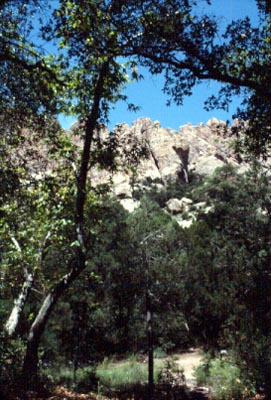
A 
C  D
D 
SECTION LISTINGS
Links to listings for sections of the genus
Amanita:
[ Amanita ]
[ Caesareae ]
[ Vaginatae ]
[ Lepidella ]
[ Amidella ]
[ Phalloideae ]
[ Validae ]
Links to listings for sections of the genus
Limacella:
[ Lubricae ]
Genus Amanita
Subgenus Amanita - spores inamyloid.
Section Amanita - Fruiting body developing in eccentric position (above center) in primordium; hence, stipe with a bulb at the base; lacking a saccate volva. Although data is absent for several taxa, all taxa in this group should be suspected of containing ibotenic acid, muscimol, or similar compounds. All photographs for this section taken by R. E. Tulloss.
[ sectional links ]
[ top ]
[ habitat information ]
[ bibliography ]
-
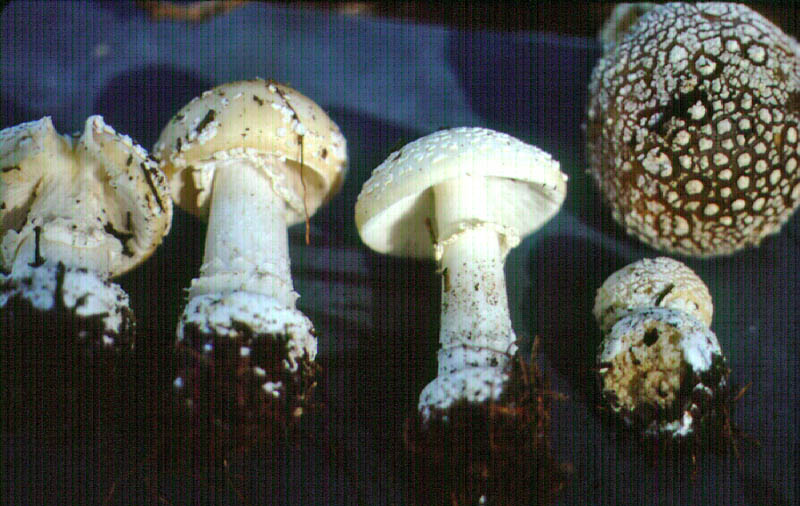
ameripanthera Tulloss nom. prov.
Spores: [140/7/3] (8.8–) 9.8–14.2 (–16.5) × (5.5–) 6.5–9.2 (–11.0) µm, (L = 10.3–12.1 (–13.2) µm; L’ = 11.5 µm; W = (6.9–) 7.2–8.1 µm; W’ = 7.5 µm; Q = (1.19–) 1.35–1.83 (–2.36); Q = 1.43–1.59 (–1.80); Q’ = 1.54)
-
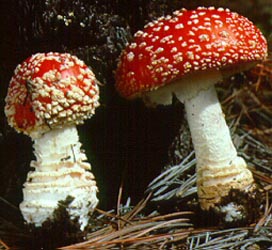
muscaria var. flavivolvata Tulloss & Geml nom. prov. (CMP (B-D).
(=muscaria subsp. flavivolvata Singer) Spores: [1017/51/40] (7.5-) 9.0 - 12.8 (-19.0) × (5.5-) 6.5 - 8.5 (-11.5) µm, (L =
(8.9-) 9.4 - 12.1 (-14.6) µm; L’ = 10.8 µm; W = (6.6-) 6.9 - 8.2 (-8.4) µm; W’ = 7.6 µm; Q = (1.11-) 1.26 - 1.67 (-2.23);
Q = (1.29-) 1.31 - 1.65 (-1.95); Q’ = 1.42). [ image 1 ]
-

xylinivolva Tulloss, Ovrebo, & Halling [CMP (C-D)] Spores
[including from isotype and paratypes]: [568/28/16] (6.2-) 8.0 - 10.2 (-12.2) × (5.2-) 7.2 - 9.5 (-10.8) µm, (L
= (8.5-) 8.6 - 9.5 (-9.8) µm; L’ = 9.1 µm; W = 7.9 - 8.8 (-9.3) µm; W’ = 8.4 µm; Q = (1.0-) 1.02 - 1.18 (-1.39);
Q = 1.05 - 1.11 (-1.15); Q’ = 1.09). [ image 3 ]
-
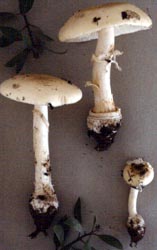
sp-AZ07 [CMP (A-E)] Spores: [60/3/3] (8.2-) 8.9 - 11.2 (-12.8) × (5.7-) 6.6 - 8.2 (-9.2) µm, (L = 9.3 - 10.2 µm;
L’ = 9.9 µm; W = 6.9 - 7.7 µm; W’ = 7.4 µm; Q = (1.11-) 1.18 - 1.46 (-1.60); Q = 1.33 - 1.36; Q’ = 1.34). A portion of the material originally assigned to this temporary code has proven to comprise pale-capped collection of Amanita ameripanthera based on molecular evidence.
[ image 4 ]
-
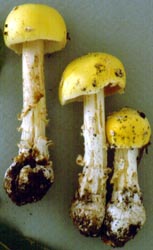
sp-AZ16 [CMP (B)] Spores: [20/1/1] (9.9-) 10.1 - 12.3 (-14.3) × (6.0-) 6.6 - 7.9 (-8.2) µm, (L = 11.9 µm; L’ = 11.9 µm; W = 7.3 µm; W’ = 7.3 µm; Q = 1.43 - 1.83 (-1.96); Q = 1.63; Q’ = 1.63).
[ image 5 ]
-
species Barrows 978 (per A. H. Sm. Spores: 10 - 13 × 9 - 10 µm; est. Q = 1.2).
-
species Barrows 1517A (per A. H. Sm. Spores: 10.8 - 12.6 × 7 - 8.5 µm; est. Q = 1.5).
-
species Barrow 19-1973 (per A. H. Sm. Spores: 10 - 12.5 × 8 - 9.5 µm; est. Q = 1.3).
Section Caesareae - Stipe annulate. Universal veil saccate and membranous, often copious. Clamps always present at bases of basidia.
[ sectional links ]
[ top ]
[ habitat information ]
-
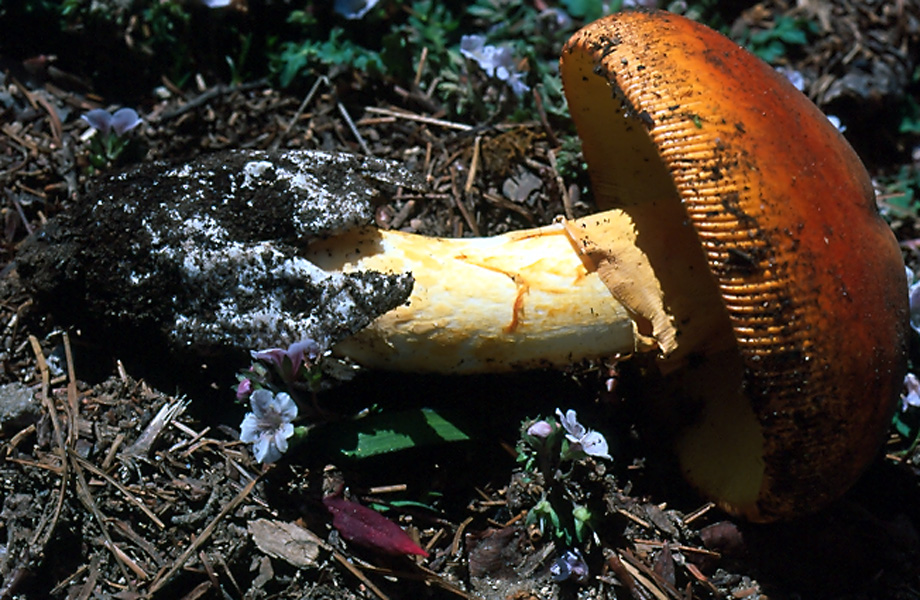
basii Guzmán & Ram.-Guill.
Spores: [1017/51/40] (7.5-) 9.0 - 12.8 (-19.0) × (5.5-) 6.5 - 8.5 (-11.5) µm, (L =
(8.9-) 9.4 - 12.1 (-14.6) µm; L’ = 10.8 µm; W = (6.6-) 6.9 - 8.2 (-8.4) µm; W’ = 7.6 µm; Q = (1.11-) 1.26 - 1.67 (-2.23);
Q = (1.29-) 1.31 - 1.65 (-1.95); Q’ = 1.42)Genetic studies have
indicated that A. basii and A. cochiseana are distinct species
(Sanchez-Ramirez et al. 2014 and 2015). Both
occur in the region of focus for this checklist.. [ image 1 ]
-


cochiseana Tulloss nom. prov. [CMP (A, C-D)] (=sp-NM07) Spores: [200/10/6] (8.2-) 9.0 - 11.9 (-13.6) × (6.0-) 6.5 - 8.1 (-9.4) µm, (L = (9.5-) 9.7 - 10.8 µm; L’ = 10.2 µm; W = 6.9 - 7.5 (-7.8) µm; W’ = 7.3 µm; Q = (1.09-) 1.25 - 1.57 (-1.78); Q = 1.40; Q’ = 1.40). [ image 11 ]
Section Vaginatae - Stipe exannulate in North American taxa. Universal veil saccate and membranous or originally saccate, but friable or becoming
friable and then pulverulent to submembranous and eventually graying/darkening entirely or on either the inner or outer surface of the volval remnants. Clamps absent, rare, or infrequent at bases of basidia.
[ sectional links ]
[ top ]
[ habitat information ]
-
barrowsii A. H. Sm. nom. prov. (per A. H. Sm. Spores: [120/6/1] (7.8-) 8.8 - 11.1 (-13.0) × (6.2-) 8.0 - 10.2 (-11.0) µm, (L = 9.4 - 11.0 µm; L’ = 10.2 µm; W = 8.3 - 9.7 µm; W’ = 9.0 µm; Q = (1.02-) 1.05 - 1.25 (-1.47); Q = 1.11 - 1.18; Q’ = 1.14).
-

castellaeTulloss, Kudzma & S. D. Russell nom. prov. u.d.
Spores:
[8/1/1] 11.5 - 14.0 (-15.1) × 10.3 - 12.7 (-13.9) μm, (L = 12.7 μm; L' = 12.7 μm; W = 11.6 μm; W' = 11.6 μm; Q = (1.03-) 1.09 - 1.14; Q = 1.09; Q' = 1.09). [ image 10 ]
-
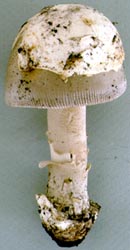
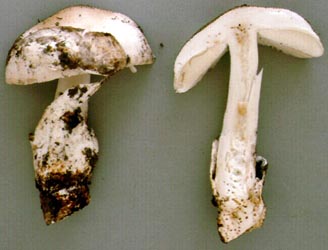
chiricahuana Tulloss nom. prov. [CMP (C-D)] Spores:
[60/3/3] (9.5-) 10.2 - 13.2 (-14.0) × (8.5-) 9.0 - 11.8 (-13.0) µm, (L = 11.6 - 11.8 µm; L’ = 11.7 µm; W = 10.3 - 10.8 µm;
W’ = 10.5 µm; Q = (1.03-) 1.04 - 1.20 (-1.25); Q = 1.09 - 1.14; Q’ = 1.11). [ image 10 ]
-
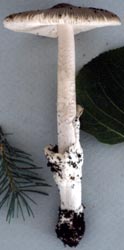
mobilimanica Tulloss nom. prov. [CMP (A-E)]. Spores:
[360/18/11] (7.7-) 9.2 - 11.8 (-15.0) × (6.1-) 8.4 - 10.5 (-14.0)µm, (L = (9.4-) 9.7 - 11.2 (-11.3) µm; L’ = 10.5 µm;
W = (8.5-) 8.9 - 9.9 (-10.0) µm; W’ = 9.4 µm; Q = (1.0-) 1.05 - 1.22 (-1.32); Q = (1.08-) 1.09 - 1.15 (-1.18);
Q’ = 1.12). [ image 12 ]
-

nishidae Tulloss nom. prov. [CMP (A-D)] Spores: [160/8/8]
(9.0-) 10.4 - 13.3 (-14.8) × (8.0-) 9.8 - 12.6 (-13.6) µm, (L = 11.1 - 12.6 (-12.8) µm; L’ = 11.9 µm; W = 10.4 - 11.7 (-12.0) µm;
W’ = 11.1 µm; Q = (1.0-) 1.03 - 1.13 (-1.23); Q = (1.05-) 1.07 - 1.10; Q’ = 1.08).
[ image 13 ]
-
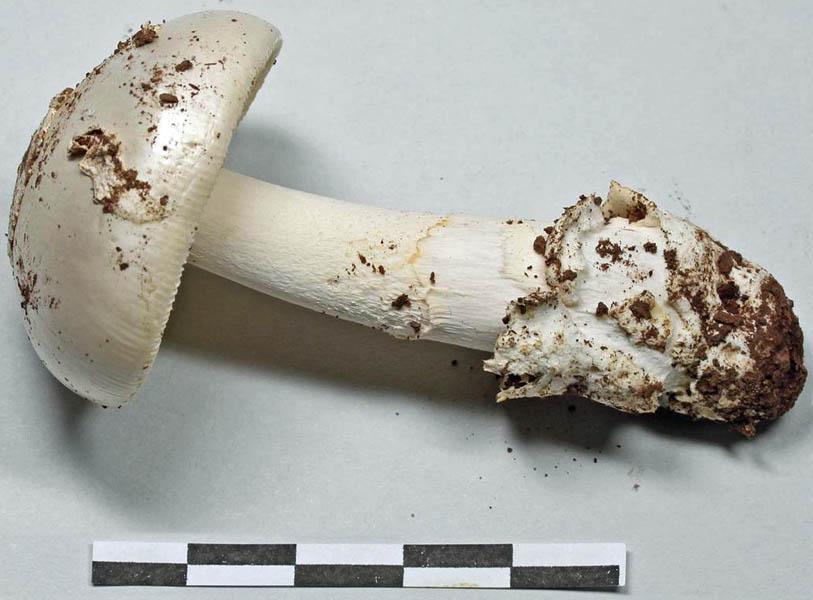
pahasapaensis Tulloss, Kudzma, and A. E. Statesl nom. prov. u.d.
Spores:
[160/6/4] (9.1-) 10.6 - 14.2 (-15.5) × (7.5-) 7.8 - 10.0 (-10.2) μm, (L = 10.8 - 13.8 μm; L' = 12.7 μm; W = 8.1 - 9.3 μm; W' = 8.9 μm; Q = (1.13-) 1.27 - 1.61 (-1.79); Q = 1.32 - 1.56; Q' = 1.44). [ image 10 ]
-
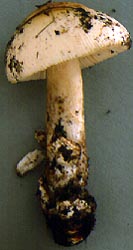
populiphila Tulloss & E. Moses (Spores: [1160/58/23] (7.0-) 9.2 - 12.5 (-21) ×
(6.0-) 8.5 - 11.5 (-15.8) µm, (L = (10.0-) 10.1 - 11.9 (-12.3) µm; L’ = 10.9 µm; W = (8.9-) 9.1 - 10.7 (-11.1) µm;
W’ = 9.8 µm; Q = (1.0-) 1.04 - 1.20 (-1.61); Q = (1.06-) 1.08 - 1.15 (-1.19); Q’ = 1.11).
[ image 14 ]
-
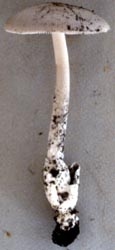
vetinummus Tulloss nom. prov. [CMP (C?, D-E)] Spores: [80/4/3] (8.2-) 8.5 - 12.5 × (6.5-) 7.2 - 10.2 (-11.5) µm, (L = 9.7 - 11.8 µm; L’ = 10.7 µm; W = 8.4 - 9.4 µm; W’ = 8.9 µm; Q = (1.06-) 1.11 - 1.39 (-1.54); Q = 1.16 - 1.26; Q’ = 1.20). [ image 15 ]
-

sp-AZ03 [CMP (D)] Spores: [20/1/1] (9.8-) 9.9 - 12.0 (-13.6) × (8.9-) 9.1 - 10.9 (-12.2) µm, (L = 10.8 µm; L’ = 10.8 µm; W = 10.0 µm; W’ = 10.0 µm; Q = (1.02-) 1.03 - 1.15 (-1.19); Q = 1.09; Q’ = 1.09). [ image 16 ]
-
sp-AZ14 [CMP (A-B, D)] Spores: [120/6/4] (8.4-) 9.4 - 12.8 (-14.7) × (6.3-) 6.6 - 9.4 (-12.2) µm, (L = 10.9 - 11.6 µm; L’ = 11.3 µm; W = 7.9 - 8.6 µm; W’ = 8.2 µm; Q = (1.14-) 1.23 - 1.60 (-1.84); Q = 1.32 - 1.47; Q’ = 1.39).
-
sp-AZ15 [CMP (B)] Spores: [81/2/2] (10.0-) 10.8 - 13.8 (-17.5) × (5.8-) 6.5 - 9.0 (-13.0) µm, (L = 11.7 - 12.6 µm; L’ = 12.1 µm; W = 7.3 - 7.9 µm; W’ = 7.6 µm; Q = (1.23-) 1.43 - 1.84 (-2.28); Q = 1.60; Q’ = 1.60).
-
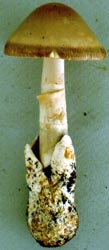
sp-AZ18 [CMP (D-E)] Spores: [40/2/2] (10.5-) 10.8 - 14.0 (-16.5) × 10.0 - 12.0 (-14.2) µm, (L = 12.0 - 12.1 µm; L’ = 12.0 µm; W = 11.0 - 11.1 µm; W’ = 11.0 µm; Q = (1.03-) 1.04 - 1.15 (-1.20); Q = 1.09; Q’ = 1.09).
[ image 19 ]
-
species Barrows 619 (per A. H. Sm. Spores: (11.0-) 11.3 - 14.1 (-15.2) × (7.8-) 8.0 - 10.1 (-10.2) µm;
Q = 1.37).
-
species Barrows 972 (per A. H. Sm. Spores: 10 - 13 × 9 - 11 µm; est. Q = 1.15).
-
species Barrows 1013 (per A. H. Sm. Spores: "9.0 - 12.5 µm in diameter").
-
species Barrows 1030 (per A. H. Sm. Spores: 10 - 14 × 9 - 11 µm; est. Q = 1.20).
-
species Barrows 1090 (per A. H. Sm. Spores: 10 - 14 µm in diameter).
-
species Barrows 1519B (per A. H. Sm. Spores: 10.5 - 13 × 8 - 9.5 (-10.0) µm; est. Q = 1.34).
-
species Barrows 2081 (per A. H. Sm. Spores: 10 - 13 × 9 - 11 µm; est. Q = 1.15).
-
species "J.D. Shields, Jr." (per A. H. Sm. Spores: 10.0 - 12.5 (-14.5) × (8.2-) 8.5 - 11.0 (-12.5) µm; Q = 1.19).
-
sp-NM01 (Spores: [60/2/1] (10.0-) 10.8 - 14.2 (-16.5) × (7.5-) 7.8 - 9.5 (-10.2) µm, (L = 12.0 - 12.5 µm; L’ = 12.2 µm; W = 8.5 - 8.6 µm; W’ = 8.6 µm; Q = (1.22-) 1.31 - 1.61 (-1.89); Q = 1.40 - 1.47; Q’ = 1.42).
-
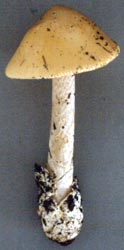
sp-NM02 (Spores: [20/1/1] (8.0-) 8.8 - 11.0 (-12.9) × (6.8-) 7.0 - 9.0 (-11.0) µm, (L = 10.0 µm; L’ = 10.0 µm; W = 8.2 µm; W’ = 8.2 µm; Q = 1.11 - 1.39; Q = 1.23; Q’ = 1.23).) [ image ]
-
sp-NM06 (Spores: [20/1/1] (10.1-) 10.6 - 13.2 (-14.3) × (7.2-) 7.7 - 9.9 (-) µm, (L = 11.7 µm;
L’ = 11.7 µm; W = 8.6 µm; W’ = 8.6 µm; Q = (1.11-) 1.20 - 1.55 (-1.83); Q = 1.37; Q’ = 1.37).
Subgenus Lepidella
Section Amidella
[ sectional links ]
[ top ]
[ habitat information ]
-
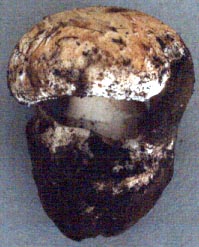
sp- AZ25 [CMP (D)] Spores: [20/1/1] (10.5-) 10.8 - 14.0 (-14.5) × (5.0-) 5.2 - 6.2 (-6.5) µm, (L = 12.0 µm;
L’ = 12.0 µm; W = 5.7 µm; W’ = 5.7 µm; Q = (1.81-) 1.83 - 2.42 (-2.55); Q = 2.10; Q’ = 2.10).
[ image 31 ]
Section Lepidella
[ sectional links ]
[ top ]
[ habitat information ]
-
arizonica A. H. Sm. nom. prov. u.d. Spores: [40/2/1] (7.2-) 7.5 - 9.5 (-9.8) × 6.5 - 8.0 (-8.2) µm, (L = 8.7 - 8.9 µm; L’ = 8.8 µm; W = 7.2 - 7.3 µm; W’ = 7.2 µm; Q = (1.04-) 1.09 - 1.31 (-1.36); Q = 1.20 - 1.23; Q’ = 1.21)
. [ image ]
-

eremites Tulloss nom. prov. Known only from a collection made on the grounds of the Desert Museum, Phoenix, Arizona, found there in a place where seed from all over the world was washed. Hence, possible imported as living mycelium in soil. Spores: [80/4/1] 9.2 - 11.2 (-12.0) × (7.2-) 7.8 - 9.0 (-10.2) µm,
(L = 10.2 - 10.4 µm; L’ = 10.3 µm; W = 8.2 - 8.3 µm; W’ = 8.3 µm; Q = (1.03-) 1.15 - 1.34 (-1.39); Q = 1.24 - 1.25; Q’ = 1.25). [ image 32 ]
-

macerisolum Often found in ordinarily dry, poor soils. Spores: [100/5/3] (8.8-) 10.2 - 13.2 (-14.5) × (6.8-) 7.5 - 9.2 (-10.8) µm, (L = 11.5 - 12.0 µm; L’ = 11.8 µm; W = 8.3 - 8.6 µm; W’ = 8.5 µm; Q = (1.22-) 1.27 - 1.52 (-1.76); Q = 1.39 - 1.40; Q’ = 1.39); photograph by Greg Wright. [ image 38 ]
-
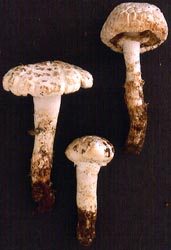
prairiicola Peck (Spores: [700/34/11] (8.0-) 10.0 - 14.0 (-19.2) × (5.2-) 6.4 - 10.0 (-12.2) µm, (L = (10.4-) 11.0 - 13.3 (-13.7) µm; L’ = 12.0 µm; W = (6.5-) 6.6 - 9.6 (-9.7) µm; W’ = 8.0 µm; Q = (1.09-) 1.26 - 1.82 (-2.31); Q = (1.30-) 1.33 - 1.75 (-1.85); Q’ = 1.51). [ image 33 ]
-
smithiana Bas (Spores: [2022/102/91] (6.5-) 8.7 - 12.0 (-16.0) × (4.3-) 5.8 - 8.0 (-10.8) µm,
(L = (8.6-) 9.4-11.2 (-11.7) µm; L’ = 10.4 µm; W = (5.5-) 6.0 - 7.4 (-7.8) µm; W’ = 6.8 µm; Q = (1.12-) 1.33 - 1.77 (-2.36); Q = (1.29-) 1.43 - 1.68 (-1.98); Q’ = 1.54).
-
species AZ12 [CMP] Spores: [20/1/1] (9.2-) 9.8 - 12.2 (-14.0) × (4.2-) 4.5 - 5.8 (-6.2) µm, (L = 10.7 µm; W = 5.3 µm;
Q = (1.76-) 1.78 - 2.57 (-2.71); Q = 2.04).
-
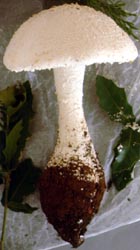
sp-AZ13 [CMP (B,D)] This species is very similar to A. polypyramis. Spores: [80/4/3] (9.1-) 9.8 - 13.8 (-16.2) × (6.2-) 6.3 - 7.8 (-90) µm, (L = 10.7 - 12.8 µm; L’ = 11.6 µm; W = 6.8 - 7.2 µm; W’ = 7.0 µm; Q = (1.32-) 1.43 - 2.0 (-2.21); Q = 1.53 - 1.89; Q’ = 1.67). [ image 36 ]
-

sp-AZ26 [CMP (A-B)] Spores: [100/4/3] (8.5-) 8.8 - 11.5 (-12.5) × (5.0-) 5.2 - 7.2 (-8.0) μm, (L = 9.5 - 10.3 μm; L' = 10.0 μm; W = 5.6 - 6.9 μm; W' = 6.1 μm; Q = (1.31-) 1.36 - 1.90 (-2.12); Q = 1.50 - 1.79; Q' = 1.65).
[ image 37 ]
Section Phalloideae - Stipe with a soft bulb and a membranous annulus. Universal veil as a limbate volva
(attached to top of bulb). Cap margin not appendiculate. No known taxa with clamped basidia. Many, but not all taxa may contain
u>amatoxins.
[ sectional links ]
[ top ]
[ habitat information ]
[ N. Amer. Phal. Key ]
-

cf. bisporigera G. F. Atk. [CMP (B-C)] (?=A. virosa ss. auct. mexic.) KOH spot test on cap negative or very weakly yellow. Spores of eastern material of KOH+ A. bisporigera: [452/19/16] (5.2-) 7.2 - 9.9 (-11.0) × (4.8-) 6.5 - 8.6 (-10.0) µm, (L = (7.8-) 7.9 - 9.2 (-9.6) µm; L’ = 8.4 µm; W = (7.0-) 7.1 - 8.1 (-8.2) µm; W’ = 7.5 µm; Q = (1.0-) 1.02 - 1.25 (-1.70); Q = (1.05-) 1.06 - 1.18 (-1.20); Q’ = 1.11). [ image 39 ]
-
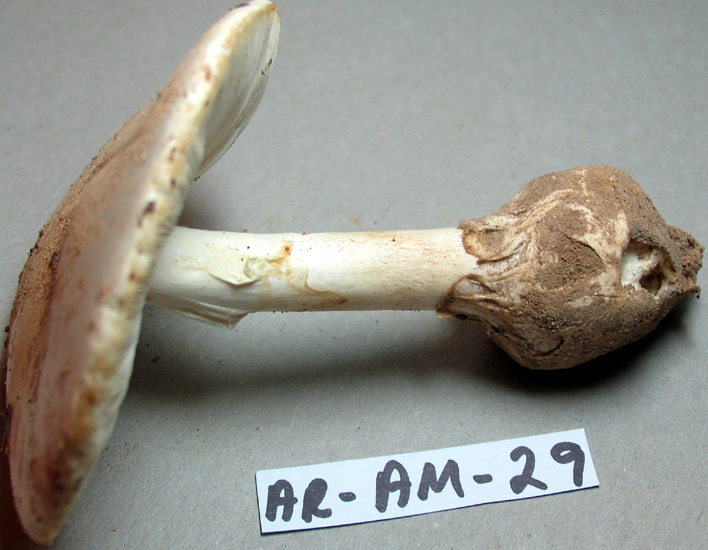
suballiacea Murrill u.d.
Spores: [97/5/4] (7.2-) 8.0 - 10.5 (-11.5) × 6.5 - 8.8 (-9.2) μm, (L = 8.7 - 10.1 μm; L' = 9.1 μm; W = 7.2 - 8.0 μm; W' = 7.5 μm; Q = (1.04-) 1.11 - 1.39 (-1.50); Q = 1.20 - 1.28; Q' = 1.22)
. [ image 10 ]
Section Validae - Stipe with a soft or firm basal bulb and a membranous annulus. Universal veil may for a low rim
around the margin of the bulb or may be entirely friable. Cap margin not appendiculate. No known taxa with clamped basidia. Marginate
species may contain bufotenine or related compounds.
[ sectional links ]
[ top ]
[ habitat information ]
-
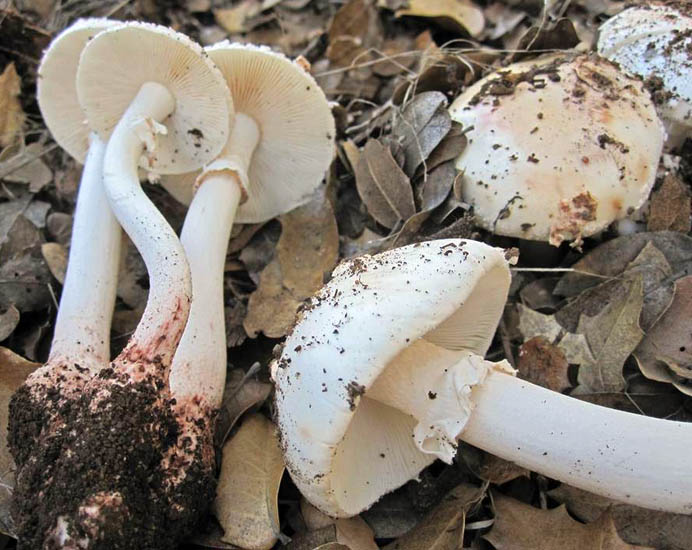
cruentilemurumTulloss, Rodr. Cayc. & K. W. Hughesl nom. prov. u.d.
Spores:
[80/4/1] (9.5-) 8.0 - 11.0 (-11.5) × (4.8-) 5.0 - 6.5 (-7.0) μm, (L = 8.8 - 9.7 μm; L' = 9.2 μm; W = 5.3 - 6.1 μm; W' = 5.7 μm; Q = (1.23-) 1.33 - 1.84 (-2.02); Q = 1.55 - 1.70; Q' = 1.61). [ image 10 ]
-
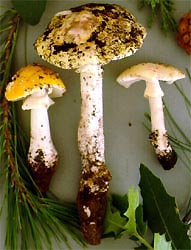
flavorubens (Berk.& Mont.) Sacc.
[CMP (A-C)] Spores: [180/9/8] (7.4-) 7.8 - 11.0 (-12.6) × (4.9-) 5.4 - 7.0 (-8.4) µm, (L = 8.3 - 9.7 ( -10.7) µm; L’ = 9.2 µm;
W = ( 5.5-) 5.7 - 6.6 µm; W’ = 6.1 µm; Q = (1.17-) 1.28 - 1.76 (-1.96); Q = ( 1.34-) 1.37 - 1.67; Q’ = 1.52).
[ image 40 ]
-

novinupta Tulloss & J. Lindgr. [CMP (A)] Spores: [1477/73/42] (6.2-) 8.2 - 10.8 (-14.8) × (4.2-) 5.5 - 7.2 (-8.8) µm, L = (8.1-) 8.6 - 10.2 (-11.0) µm; L’ = 9.3 µm; W = (5.5-) 6.0 - 6.8 (-7.2) µm; W’ = 6.3 µm; Q = (1.13-) 1.31 - 1.69 (-2.47); Q = (1.34-) 1.39 - 1.58 (-1.72); Q’ = 1.48).
[ image 42 ]
-
sp-AZ01 [CMP (A-C)] Spores: (6.7-) 7.5 - 10.0 (-11.0) × (5.2-) 5.5 - 7.5 (-8.5) µm; Q = 1.38 - 1.50).
-
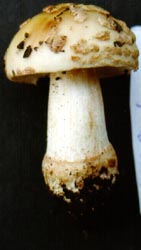
sp-AZ10 [CMP (D)] Spores: [120/6/5] (7.8-) 8.2 - 10.5 (-11.5) × (5.2-) 5.5 - 6.8 (-7.8) µm, (L = 8.8 - 10.1 µm; L’ = 9.2 µm; W = 5.8 - 6.3 µm; W’ = 6.0 µm; Q = (1.31-) 1.36 - 1.69 (-1.81); Q = 1.43 - 1.61; Q’ = 1.53).
[ image 44 ]
-
sp-AZ28 u.d.
Spores:
[80/4/3] (9.6-) 10.1 - 14.0 (-15.0) × (7.5-) 8.8 - 12.5 (-13.5) μm, (L = 11.2 - 12.3 μm; L' = 11.7 μm; W = 9.9 - 11.0 μm; W'= 10.3 μm; Q = (1.04-) 1.06 - 1.25 (-1.39); Q = 1.11 - 1.15; Q'= 1.13). [ image 10 ]
-
sp-AZ31 u.d.
Spores:
. [ image 10 ]
Genus Limacella
Section Lubricae
[ sectional links ]
[ top ]
[ habitat information ]
-

glischra (Morgan) Murrill Spores:[20/1/1] (3.6-) 3.9 - 4.6 (-5.3) × 3.5 - 4.4 (-5.0) µm, (L= 4.3 µm; L’ = ? µm; W = 3.9 µm; W’ = ? µm; Q = 1.03 - 1.15 (-1.16); Q = 1.10; Q’ = ?). [ image 47 ]
-
sp-CMP0152 Pileus white with some tannish coloration over the disc, very glutinous. Spores: [97/5/4] (4.0–) 4.1 – 5.5 (–6.5) × (3.0–) 3.4 – 4.3 (–4.7) µm, (L = 4.6 – 5.0 µm; L’ = 4.8 µm; W = 3.6 – 3.9 µm; W’ = 3.8 µm; Q = (1.10–) 1.14 – 1.43 (–1.59); Q = 1.25 – 1.32; Q’ = 1.28).
-
sp-CMP3806-1 Pileus white. Spores: [20/1/1] 4.5 - 6.0 (-6.3) × 3.0 - 3.6 (-3.8) μm, (L = 5.3 μm; W = 3.4 μm; Q = (1.29-) 1.31 - 1.80 (-1.87); Q = 1.52).
BIBLIOGRAPHY
(partial and a bit out-of-date)
[ sectional links ]
[ top ]
[ habitat information ]
Bas, C. 1969. Morphology and subdivision of
Amanita and a monograph of
its section
Lepidella,.
Persoonia 5(4): 285-579.
Nishida, F. H., W. J. Sundberg. J. A. Menge,
J. S. States, R. E. Tulloss and J. Cifuentes Blanco. 1992. Studies in
the mycoflora of the Chiricahua Mountains, Cochise County, Arizona,
U.S.A. I. Preliminary report on species distribution, ecology, and
biogeographical affinities.
Chiricahua Mountains Research Symposium.
16-17 August 1992: 35-38.
Sánchez-Ramírez, S., R. E. Tulloss, M. Amalfi, J.-M. Moncalvo. 2014. Palaeotropical origins, boreotropical distribution and increased rates of diversification in a clade of edible ectomycorrhizal mushrooms (Amanita section Caesareae). J. Biogeogr. 2014: 1-13. doi: 10.1111/jbi.12402
Sánchez-Ramírez, S., R. E. Tulloss, L. Guzmán- Dávalos, J. Cifuentes-Blanco, R. Valenzuela, A. Estrada-Torres, Felipe Ruán-Soto, R. Díaz-Moreno, N. Hernández-Rico, M. Torres-Gómez, H. León, J.-M. Moncalvo . 2015. In and out of refugia: historical patterns of diversity and demography in the North American Caesar's mushroom species complex. Molec. Ecol. 24(23): 5938-5956. doi: 10.1111/mec.13413
Tulloss, R. E. 2005.
Amanita—distribution in the Americas with comparison to eastern and southern Asia and notes on spore character variation with latitude and ecology.
Mycotaxon 93: 189-231..
Tulloss, R. E. and J. Geml. in revision. Red fly agarics...
Tulloss, R. E. and J. E. Lindgren. 1992.
Amanita smithiana—taxonomy, distribution, and poisonings.
Mycotaxon 45: 373-387.
Tulloss, R. E. and J. E. Lindgren. 1994
Amanita novinupta—a rubescent, white species from the western United States and southwestern Canada.
Mycotaxon 51: 179-190.
Last change of this page: 29 June 2021.
This page is maintained by R. E. Tulloss.




 D
D 































